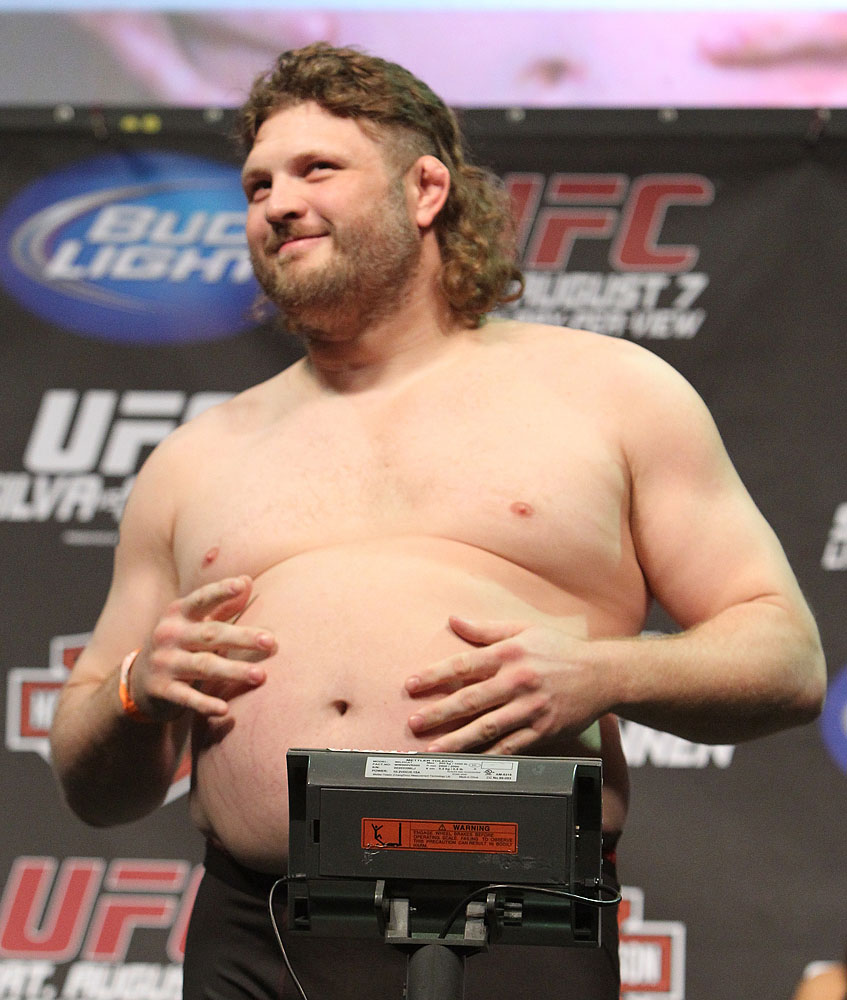In preparation for writing this column, yours truly has done
a fair bit of research on the career of Chael Sonnen (read: watching youtube
videos of Chael dominating, then tapping out immediately after getting caught
in a submission). Losses to Jeremy Horn
(x3), Forrest Griffin, Trevor Prangley, Babalu Sobral, Demian Maia, and
Anderson Silva (among others) have proved to be the defining moments of an
otherwise stellar career.
Tomorrow night, facing the best pound for pound fighter in
mma history not named Fedor, Sonnen is going to find himself in an interesting
position: against an opponent he cannot take down. There is almost unanimous agreement that
Chael will lose tomorrow night; the more interesting question is how he will lose.
Breakdown: On the
Feet
Jon Jones is not a great striker, but he has a combination
of skills and physical traits that make him formidable on the feet. Jones possesses surprising agility and speed for a man his
size. Those traits,
combined with his imaginative combinations, surprising flexibility, penchant
for violence, raptor-like reach, and complete lack of fear of getting taken down, make him dangerous. Having seen all of his UFC fights, several
things stand out. Jon Jones is not
confident in punching exchanges; he is additionally vulnerable to quick-fisted
strikers who have the footspeed and movement to get inside of his reach, and
can make him pay for throwing kicks.
The only time in Jones’ career in which he legitimately
looked like the lesser fighter was in the first round of his title defense
against Lyoto Machida.
Against a foe
fleeter of hand and foot, with a PhD in movement and angles, Jones looked
lost. Machida pot-shotted him all round,
and kept Jones off balance. Jon likes to
use his kicks to control the distance, but against someone who was able to
control the range (and in so doing, counter Jones’ kicks with effective
punches), Jones had little to offer on the feet.
After more of the same in the early part of the second round, Jones
finally was able to take Machida down, land a massive, blinding
(literally—Machida said he could not see) elbow, and finish ‘The Dragon’ with a
choke. Jones showed good composure on
the feet in the fight, and the ability to respond to challenging
situations.
Against Rampage, a fearsome puncher with limited footspeed
and flexibility, Jones landed a series of kicks—front kicks, spin kicks, knees,
and low kicks. He was able to control
the distance and batter Rampage (although never came close to stopping him, or
ever seemed to hurt him, actually). In
the most memorable moment of the fight, Jones actually ran away from Rampage
when the latter finally got into punching range. Jones does not have a bad chin, but he does
not like getting hit.
Against Rashad Evans, who possesses much better foot speed
(but a far softer jaw) than Rampage, Jon Jones utilized elbows in a way I had never seen before in MMA. He literally
used his elbows as fists:
Against Stephan Bonner, Shogun, and Matt Hamill, Jones
showed off more of his amazing and unorthodox striking skills:
By contrast, Chael Sonnen’s repertoire is quite
limited. Instead of flashy kicks and
spinning elbows, Chael relies on his tight boxing, bully strength, and
excellent takedowns to create openings to exploit on the feet.
While Chael has good hands, nice head movement, and
aggression working for him, he is not super-fast, and his chin is nothing to
write home about. Further, given how
good of a wrestler Jones is, as well as how dangerous Jones is in the clinch
with his knees and elbows, Chael is not going to have many good options
striking; if he lets Jones determine the distance, Jon will use his feet to
keep Chael away. If Chael closes the
distance, he is going to find himself running into knees, elbows, and
takedowns. Advantage: Jones.
In the clinch, Jon Jones has shown a crazy combination of
strikes, foot sweeps, and grip strength.
Chael is actually likely to be the stronger man, and has a better
wrestling pedigree than Jones, but despite that, he is going to find himself in a world of
hurt (likely on his back) if he lets Jones get a hold of him. Why? Because Jones' combination of wrestling acumen, athleticism, size, fluidity of movement, and creativity make him the de facto best wrestler in the weight class, regardless of amateur wrestling accomplishments.
Thus, it would seem that Chael’s only real chance is to take
Jones down, while also avoiding the clinch.
That means shooting in on a man with extremely long limbs, a tremendous
wrestling background, and sharp knees.
If anyone can take Jones down, it is Chael; Sonnen has explosive
strength in his double-leg, has a knack for getting in takedown range, and has
the mental fortitude to keep fighting for the takedown if his initial effort is
rebuffed.
As we saw in the first Anderson Silva vs Chael Sonnen fight, Chael also has the ability to transition from punches to takedowns quite well--he is no Fedor in this regard (enjoy the GIF of the GOAT below), but he is still talented enough at both punching and takedowns (especially the latter) to keep his opponents off-guard.
Chael is no Fedor:
However, even if Chael can get
Jones down, so what? Chael was on top of
Anderson Silva for a full 6 rounds and wasn’t able to finish ‘The Spider’,
although he certainly did land a considerable number of damaging blows.

Chael is going to need a similar output against Jones, and has to pray that he can land something big to hurt the champion. In terms of submissions, Chael has scored several during his career, but more often than not, if he is involved in a fight ending in a submission, it is Chael tapping out.

Chael is going to need a similar output against Jones, and has to pray that he can land something big to hurt the champion. In terms of submissions, Chael has scored several during his career, but more often than not, if he is involved in a fight ending in a submission, it is Chael tapping out.
If, on the other hand, Jones ends up on top of Sonnen, the game
is over. Jon Jones is the single most violent
fighter I have ever seen in the UFC (Wanderlei Silva in Pride was a more
violent fighter, but the rules in those days favored such violence, given the
inclusion of soccer kicks and head stomps).
Jones gets more torque on his
elbows than anyone in the history of the sport due to a combination of wingspan
and technique. He is a savage in the
cage, a true master of inflicting terrible damage.
Breaking Brandon Vera's face:
Choking out Bader:
Choking out Machida:
Choking out Rampage:
Beating Shogun to the point that I was worried for the latter's life. Notice that Shogun actually taps out AFTER the ref has already stopped the fight:
PREDICTION: Jones KO 2






































